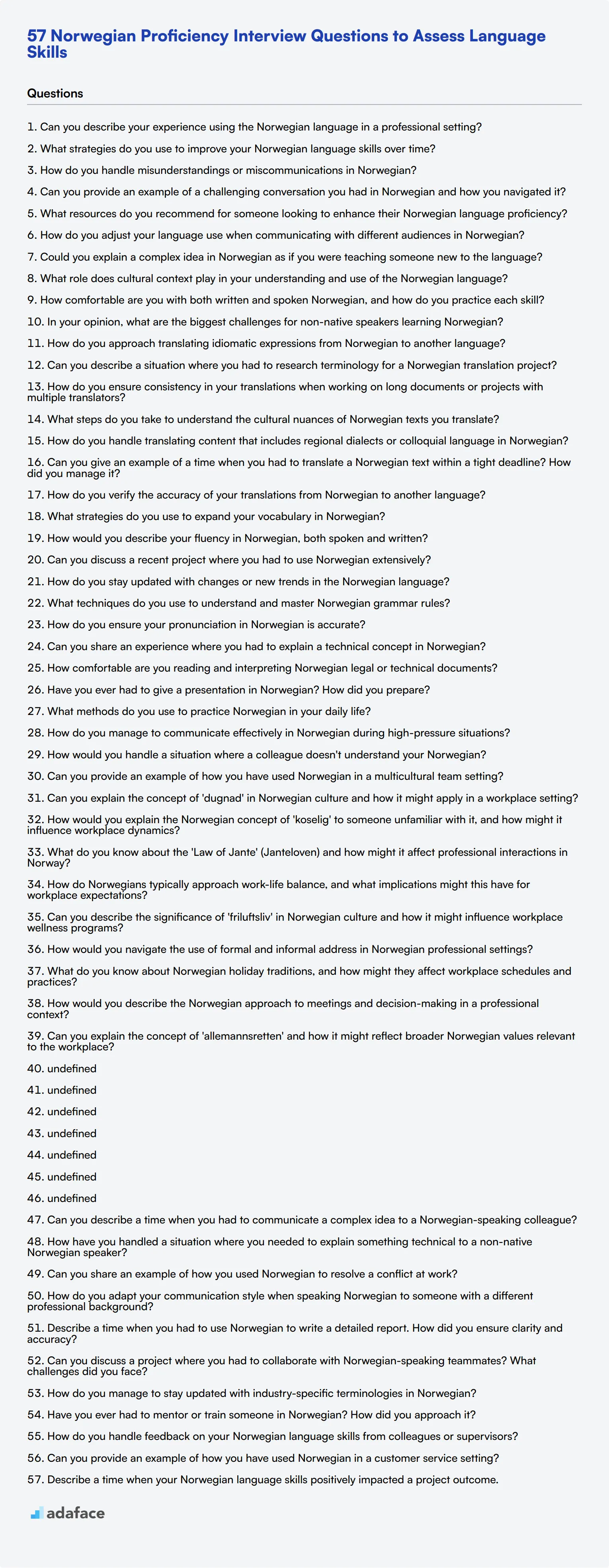Hiring the right candidate for Norwegian translation roles requires more than just a strong resume. Knowing which questions to ask during an interview is fundamental to assessing a candidate's true proficiency, just as crucial as other recruiting strategies.
This post provides you with a comprehensive list of Norwegian Proficiency interview questions, organized to enhance your interview process. We've included targeted questions for different expertise levels, from junior translators to top professionals.
Using these questions, you can efficiently gauge the language and cultural proficiency of your candidates. For a more streamlined hiring process, consider utilizing our language proficiency tests prior to interviews.
Table of contents
10 Norwegian Proficiency interview questions to initiate the interview

When assessing candidates' Norwegian language skills, using targeted interview questions is vital. This list can help you gauge their proficiency effectively, ensuring they meet the requirements for the role. For more insights on relevant job roles, visit our job descriptions.
- Can you describe your experience using the Norwegian language in a professional setting?
- What strategies do you use to improve your Norwegian language skills over time?
- How do you handle misunderstandings or miscommunications in Norwegian?
- Can you provide an example of a challenging conversation you had in Norwegian and how you navigated it?
- What resources do you recommend for someone looking to enhance their Norwegian language proficiency?
- How do you adjust your language use when communicating with different audiences in Norwegian?
- Could you explain a complex idea in Norwegian as if you were teaching someone new to the language?
- What role does cultural context play in your understanding and use of the Norwegian language?
- How comfortable are you with both written and spoken Norwegian, and how do you practice each skill?
- In your opinion, what are the biggest challenges for non-native speakers learning Norwegian?
8 Norwegian Proficiency interview questions and answers to evaluate junior translators
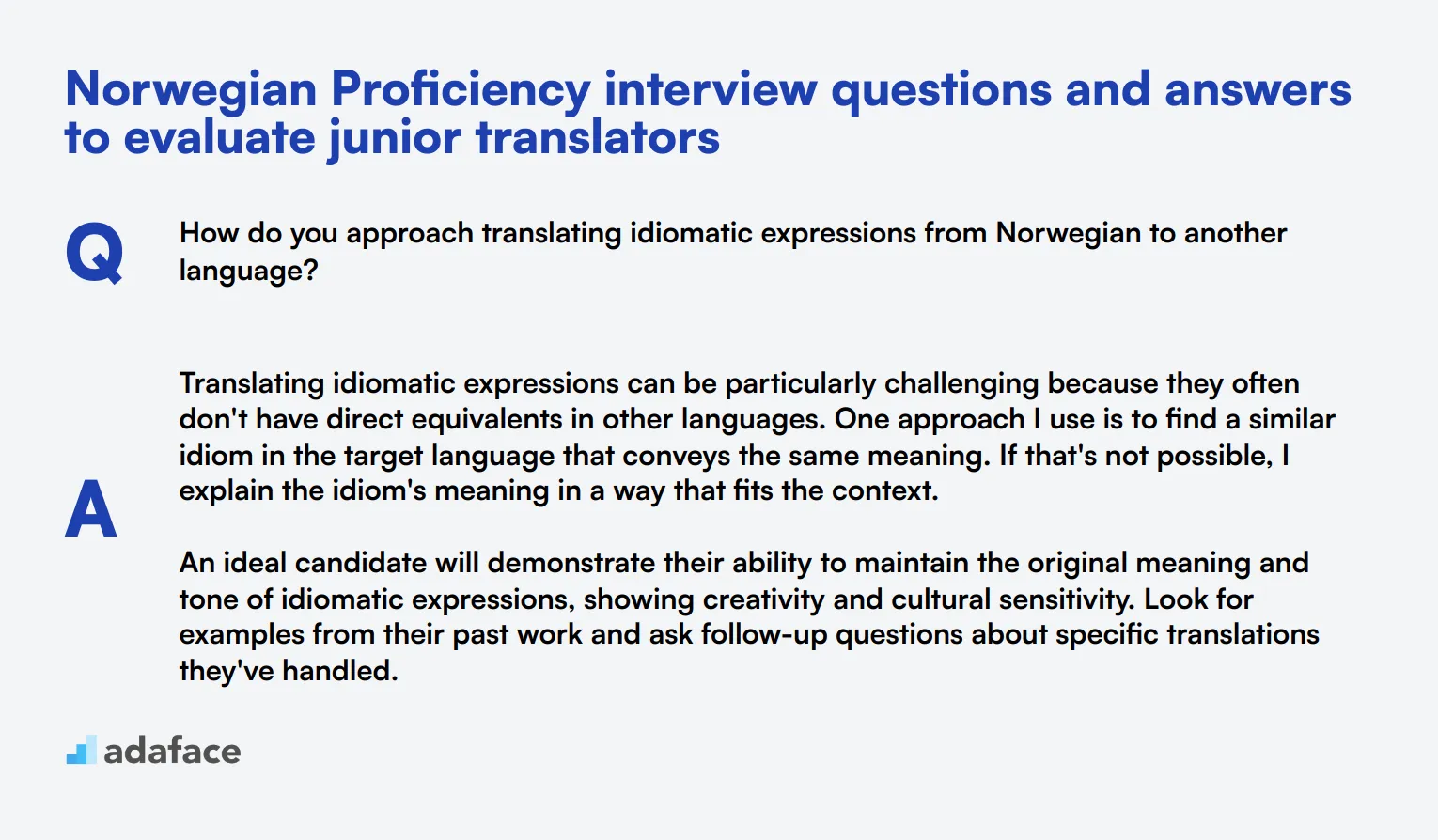
To effectively evaluate the Norwegian language skills of junior translators, use these questions during your interviews. They're designed to reveal practical language proficiency and cultural understanding, ensuring you find the best fit for your team.
1. How do you approach translating idiomatic expressions from Norwegian to another language?
Translating idiomatic expressions can be particularly challenging because they often don't have direct equivalents in other languages. One approach I use is to find a similar idiom in the target language that conveys the same meaning. If that's not possible, I explain the idiom's meaning in a way that fits the context.
An ideal candidate will demonstrate their ability to maintain the original meaning and tone of idiomatic expressions, showing creativity and cultural sensitivity. Look for examples from their past work and ask follow-up questions about specific translations they've handled.
2. Can you describe a situation where you had to research terminology for a Norwegian translation project?
When working on a technical document for a client in the medical field, I encountered several terms that were unfamiliar to me. I spent time researching these terms using medical dictionaries, online resources, and consulting with experts in the field to ensure accuracy.
A strong candidate will explain the importance of understanding context and using reliable sources. They should highlight their research skills and their commitment to delivering precise translations.
3. How do you ensure consistency in your translations when working on long documents or projects with multiple translators?
To maintain consistency, I use translation memory tools and glossaries. These tools help track specific terminology and phrasing. Additionally, I communicate regularly with other team members to align on style and terminology.
Look for candidates who emphasize the importance of tools and collaboration in maintaining consistency. Their answer should show they are detail-oriented and proactive in avoiding discrepancies.
4. What steps do you take to understand the cultural nuances of Norwegian texts you translate?
Understanding cultural nuances is crucial for accurate translation. I immerse myself in Norwegian culture through literature, films, and news. I also consult native speakers and cultural experts to ensure I grasp the subtleties in the text.
Candidates should demonstrate their dedication to cultural understanding. Look for examples of how they've incorporated cultural insights into their translations and ask about specific challenges they've faced.
5. How do you handle translating content that includes regional dialects or colloquial language in Norwegian?
When dealing with regional dialects or colloquial language, I first identify the target audience to decide whether to maintain the dialect or translate it into standard Norwegian. I aim to retain the original flavor while ensuring comprehensibility for the audience.
An ideal response will show the candidate's ability to balance authenticity with clarity. They should provide examples of how they've handled similar translations and the reasoning behind their choices.
6. Can you give an example of a time when you had to translate a Norwegian text within a tight deadline? How did you manage it?
Once, I was assigned a last-minute project that required translating a lengthy legal document. I prioritized tasks, used translation software to speed up the process, and worked extended hours to meet the deadline without compromising quality.
Look for evidence of time management skills and the ability to work under pressure. Candidates should demonstrate their commitment to maintaining quality even under tight deadlines.
7. How do you verify the accuracy of your translations from Norwegian to another language?
I cross-check my translations with multiple sources and use peer reviews to ensure accuracy. I also read the translated text aloud to see if it flows naturally and makes sense in the target language.
Strong candidates will emphasize their meticulous review process and willingness to seek feedback. Their answer should highlight their commitment to delivering high-quality, accurate translations.
8. What strategies do you use to expand your vocabulary in Norwegian?
I regularly read Norwegian literature, newspapers, and online articles to expose myself to new words and phrases. I also use vocabulary-building apps and participate in language exchange programs with native speakers.
Candidates should show a proactive approach to continuous learning. Look for a variety of methods they use to keep their language skills sharp and up-to-date.
12 Norwegian Proficiency interview questions about language fluency
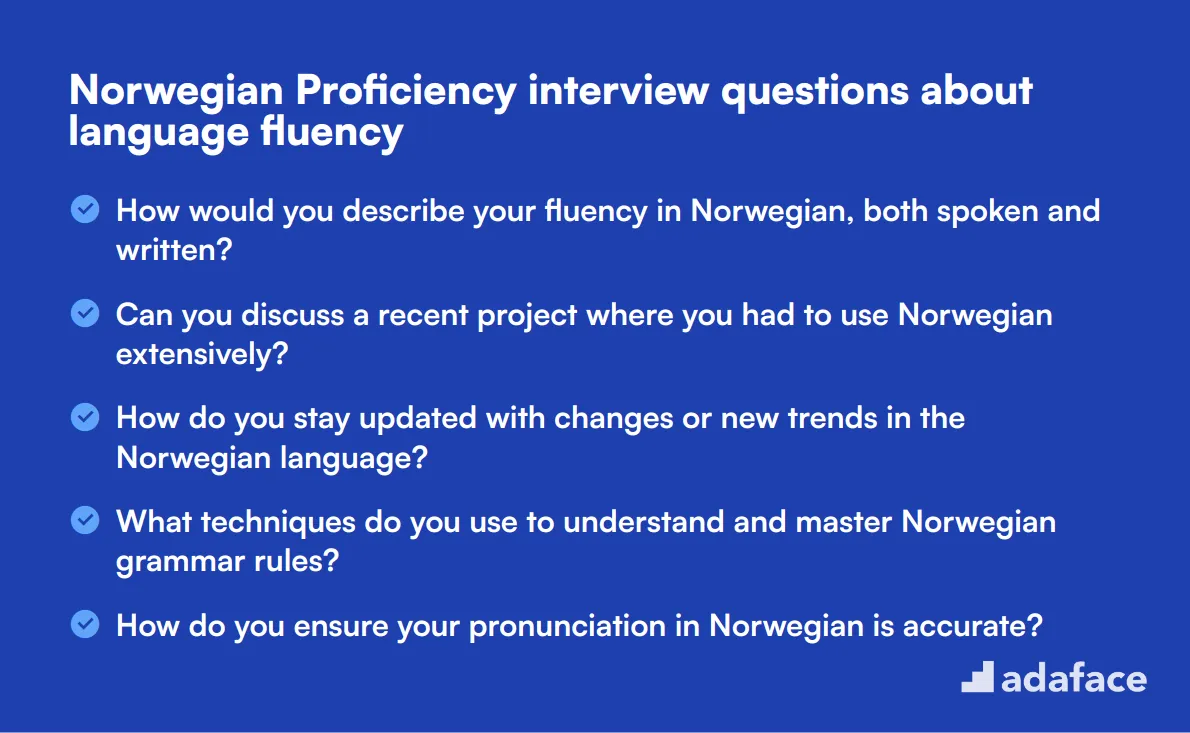
To gauge whether candidates possess the required language fluency for the role, consider using these 12 Norwegian Proficiency interview questions. These questions will help you assess their ability to communicate effectively in Norwegian, ensuring they can perform tasks efficiently and fit seamlessly into your team.
- How would you describe your fluency in Norwegian, both spoken and written?
- Can you discuss a recent project where you had to use Norwegian extensively?
- How do you stay updated with changes or new trends in the Norwegian language?
- What techniques do you use to understand and master Norwegian grammar rules?
- How do you ensure your pronunciation in Norwegian is accurate?
- Can you share an experience where you had to explain a technical concept in Norwegian?
- How comfortable are you reading and interpreting Norwegian legal or technical documents?
- Have you ever had to give a presentation in Norwegian? How did you prepare?
- What methods do you use to practice Norwegian in your daily life?
- How do you manage to communicate effectively in Norwegian during high-pressure situations?
- How would you handle a situation where a colleague doesn't understand your Norwegian?
- Can you provide an example of how you have used Norwegian in a multicultural team setting?
9 Norwegian Proficiency interview questions and answers related to cultural understanding

When assessing Norwegian proficiency, cultural understanding is just as crucial as language skills. These questions will help you gauge a candidate's grasp of Norwegian customs, traditions, and social norms. Use them to evaluate candidates holistically, ensuring they can navigate both linguistic and cultural aspects of Norwegian communication effectively.
1. Can you explain the concept of 'dugnad' in Norwegian culture and how it might apply in a workplace setting?
Dugnad is a Norwegian cultural tradition of communal work or voluntary participation in a collective task. It's deeply rooted in Norwegian society and represents the idea of coming together to achieve a common goal without expectation of personal gain.
In a workplace setting, dugnad might manifest as employees voluntarily staying late to help meet a deadline, organizing office clean-up days, or collaborating on projects outside of their usual responsibilities. It emphasizes teamwork, community spirit, and shared responsibility.
Look for candidates who demonstrate an understanding of this collective mindset and can provide examples of how they've participated in or would encourage dugnad-like activities in a professional environment. This indicates their ability to adapt to and embrace Norwegian work culture.
2. How would you explain the Norwegian concept of 'koselig' to someone unfamiliar with it, and how might it influence workplace dynamics?
Koselig is a Norwegian concept that goes beyond its English translation of 'cozy'. It encompasses a feeling of warmth, intimacy, and well-being. It's about creating a comfortable and pleasant atmosphere, both physically and emotionally.
In a workplace, koselig might influence dynamics by encouraging a more relaxed and friendly environment. This could include having comfortable break areas, organizing social gatherings, or fostering open and warm communication among team members.
An ideal response should show that the candidate understands the importance of creating a positive and welcoming atmosphere in the workplace. Look for examples of how they might implement koselig principles in team-building or daily office life, demonstrating their ability to contribute to a harmonious work environment.
3. What do you know about the 'Law of Jante' (Janteloven) and how might it affect professional interactions in Norway?
The Law of Jante, or Janteloven, is a cultural concept in Nordic countries, including Norway, that emphasizes collective well-being over individual success. It discourages boasting and promotes humility and equality.
In professional interactions, Janteloven might manifest as a preference for understated communication, teamwork over individual achievement, and a flatter organizational hierarchy. Employees might be less likely to highlight personal accomplishments and more focused on collective success.
A strong answer should demonstrate awareness of this cultural norm and its potential impact on workplace behavior. Look for candidates who can discuss how they would adapt their communication style or leadership approach to align with these values, showing cultural sensitivity and adaptability.
4. How do Norwegians typically approach work-life balance, and what implications might this have for workplace expectations?
Norwegians generally place a high value on work-life balance. This is reflected in policies like generous parental leave, shorter working hours (often 7.5 hours per day), and an emphasis on leisure time and outdoor activities.
In the workplace, this cultural value might translate to strict adherence to working hours, respect for vacation time, and an understanding that employees have commitments outside of work. There's often an expectation that work should not regularly intrude on personal time.
Look for responses that show an understanding of this balance and how it might differ from other work cultures. Candidates should be able to discuss how they would adapt to or support this approach, perhaps by mentioning efficient time management or respecting colleagues' personal time.
5. Can you describe the significance of 'friluftsliv' in Norwegian culture and how it might influence workplace wellness programs?
Friluftsliv, which translates to 'open-air living', is a Norwegian philosophy that emphasizes the importance of spending time outdoors and connecting with nature. It's deeply ingrained in Norwegian culture and is seen as essential for physical and mental well-being.
In a workplace context, friluftsliv might influence wellness programs by encouraging outdoor team-building activities, providing time for employees to enjoy nature during the workday, or organizing company trips that involve outdoor adventures.
A good response should demonstrate an understanding of this concept and its potential benefits for employee well-being. Look for candidates who can suggest creative ways to incorporate friluftsliv into workplace culture, showing their ability to align with Norwegian values while promoting employee health and satisfaction.
6. How would you navigate the use of formal and informal address in Norwegian professional settings?
In Norwegian professional settings, the use of formal and informal address can be nuanced. Generally, Norwegians tend to be less formal than in some other cultures, often using first names and the informal 'du' (you) rather than the formal 'De' in most workplace situations.
However, it's important to be aware of hierarchy and context. In initial meetings or with high-ranking officials, a more formal approach might be appropriate. The transition to informal address often happens quickly, but it's polite to wait for cues from the other person.
Look for answers that demonstrate an understanding of this balance and the ability to adapt. Candidates should show awareness that while Norwegian workplace culture is generally informal, they need to be sensitive to individual preferences and situational context. This indicates their ability to navigate social nuances in professional settings.
7. What do you know about Norwegian holiday traditions, and how might they affect workplace schedules and practices?
Norwegian holiday traditions include celebrations like Constitution Day (May 17th), Christmas (Jul), and Easter (Påske). These holidays often involve extended time off work and specific cultural practices. For example, many businesses slow down or close entirely between Christmas and New Year's, known as 'romjul'.
In the workplace, these traditions might affect schedules with longer holiday breaks, especially around Christmas and Easter. There may also be specific celebrations or customs observed in the office, such as holiday parties or traditional foods.
A strong response should demonstrate familiarity with major Norwegian holidays and an understanding of their potential impact on work rhythms. Look for candidates who can discuss how they would adapt to these schedules and potentially participate in holiday-related workplace activities, showing cultural awareness and flexibility.
8. How would you describe the Norwegian approach to meetings and decision-making in a professional context?
The Norwegian approach to meetings and decision-making often reflects cultural values of equality, consensus, and efficiency. Meetings tend to be structured and focused, with an emphasis on hearing all voices and reaching a collective agreement.
Decision-making processes often involve extensive discussion and input from all team members, regardless of hierarchical position. This can sometimes lead to longer decision-making processes, but it ensures that all perspectives are considered and that there's broad support for the final decision.
Look for responses that show an understanding of this collaborative approach. Candidates should demonstrate their ability to participate effectively in such a system, perhaps by mentioning skills like active listening, clear communication, and the ability to build consensus. This indicates their potential to integrate well into Norwegian professional environments.
9. Can you explain the concept of 'allemannsretten' and how it might reflect broader Norwegian values relevant to the workplace?
Allemannsretten, or 'the right to roam', is a traditional right in Nordic countries that allows public access to nature, regardless of land ownership. In Norway, it permits people to hike through or camp on uncultivated land, even if it's privately owned, as long as they show respect for nature and landowners.
This concept reflects broader Norwegian values such as equality, trust, respect for nature, and the belief that certain resources should be accessible to all. In a workplace context, these values might translate to open communication, flat hierarchies, environmental responsibility, and a focus on collective well-being.
An ideal response should demonstrate an understanding of how allemannsretten embodies core Norwegian values. Look for candidates who can draw parallels between this concept and workplace principles, such as transparency, shared responsibility, or sustainable practices. This shows their ability to grasp and apply Norwegian cultural values in a professional setting.
7 situational Norwegian Proficiency interview questions with answers for hiring top translators
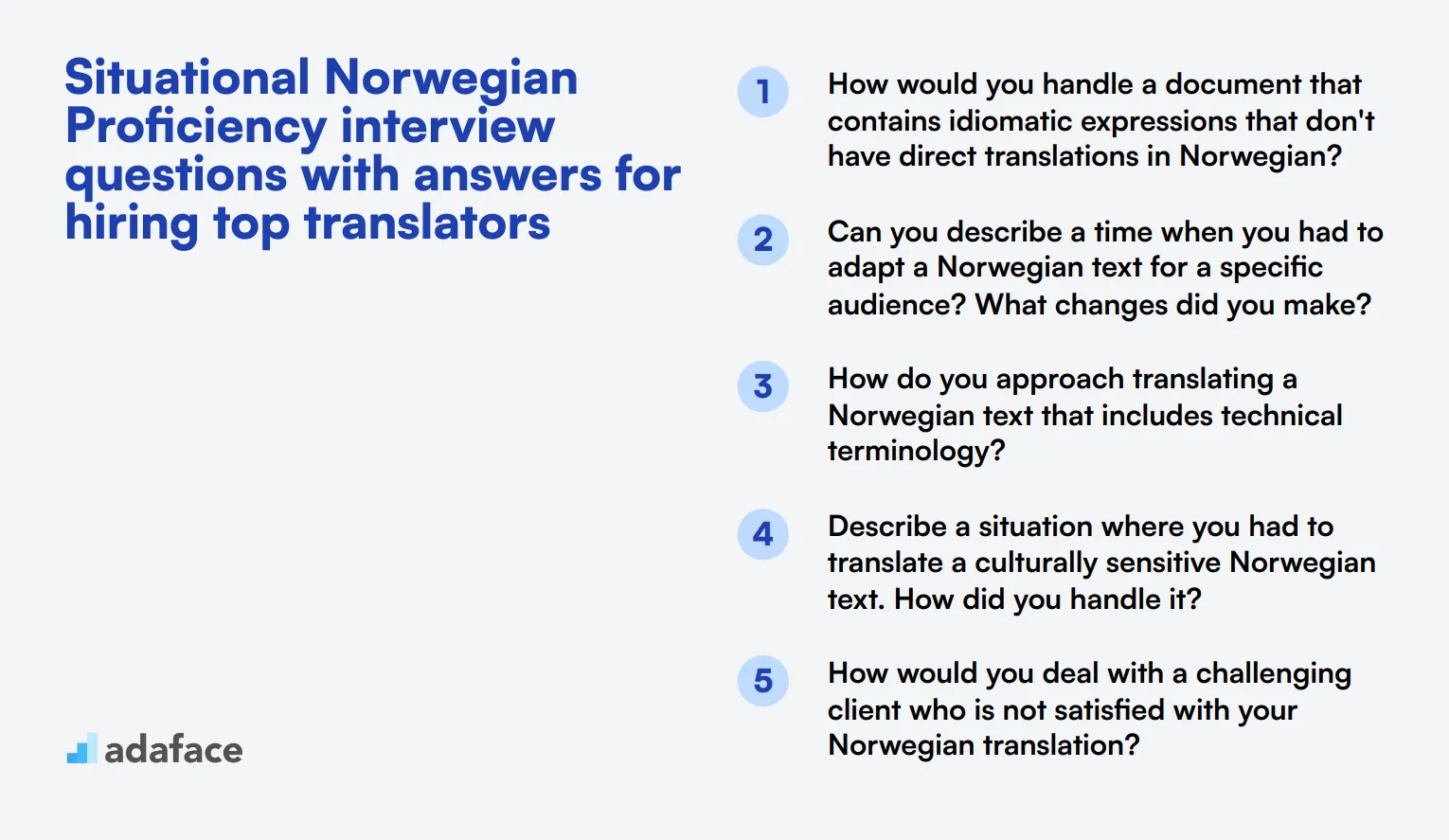
To make sure you're hiring the best translators for your team, use these situational Norwegian proficiency interview questions. These questions will help you assess your candidates' real-world application of the language, ensuring they possess both linguistic and cultural fluency.
1. How would you handle a document that contains idiomatic expressions that don't have direct translations in Norwegian?
When dealing with idiomatic expressions that don't have direct translations, it's important to understand the underlying meaning or intent of the expression. I would start by researching the idiom's cultural context and usage to grasp its essence. Then, I would find a comparable expression in Norwegian that conveys the same sentiment, even if it's not a word-for-word match.
It's crucial to maintain the tone and intention of the original text. If a direct equivalent is impossible, I might add a brief explanation or footnote to ensure the reader understands the intended meaning. A good translator should always prioritize clarity and cultural relevance over literal translation.
Look for candidates who demonstrate a deep understanding of both source and target languages and cultures. They should be able to balance fidelity to the original text with the need for clarity and relatability for the target audience.
2. Can you describe a time when you had to adapt a Norwegian text for a specific audience? What changes did you make?
I once had to adapt a Norwegian marketing brochure aimed at tech-savvy millennials. The original text was written in a formal tone, which was not engaging for the younger audience. I modified the language to be more conversational and included contemporary slang and references that resonated with the demographic.
I paid close attention to the visuals and layout as well, ensuring they were modern and appealing. I also removed or simplified technical jargon to make the content more accessible without losing key information.
Ideal responses will showcase the candidate's ability to tailor their translations to suit different audiences. Look for examples where they have successfully navigated tone, style, and content adjustments to meet specific needs.
3. How do you approach translating a Norwegian text that includes technical terminology?
When translating texts with technical terminology, my first step is to ensure I fully understand the terms. I often consult specialized dictionaries, glossaries, or industry-specific resources. If necessary, I may reach out to subject matter experts to clarify any ambiguous terms.
I aim to maintain consistency with technical terms throughout the document. This often involves creating a glossary of terms that can be referenced by other translators or editors working on the same project. Accurate and consistent use of terminology is critical for maintaining the integrity of the text.
Candidates should highlight their research skills and attention to detail when discussing how they handle technical terminology. Look for their ability to maintain accuracy and clarity in specialized content.
4. Describe a situation where you had to translate a culturally sensitive Norwegian text. How did you handle it?
I once translated a Norwegian text about a sensitive historical event. To handle this, I first educated myself thoroughly on the topic, ensuring I understood the cultural and emotional nuances. I was careful to choose words that conveyed respect and sensitivity, avoiding any language that could be misunderstood or offensive.
I also consulted with native speakers and cultural experts to ensure my translation was appropriate and respectful. This collaborative approach helped me produce a text that was both accurate and considerate of the cultural context.
An ideal candidate will demonstrate both cultural sensitivity and collaboration skills. They should show a willingness to seek input from others to ensure their translations are respectful and appropriate.
5. How would you deal with a challenging client who is not satisfied with your Norwegian translation?
In dealing with a challenging client, I would first listen carefully to their concerns to understand their perspective. Open communication is key. I would then review the translation with their feedback in mind, making necessary adjustments while explaining my choices and the reasons behind them.
If the client has specific preferences or requirements, I would incorporate those into the revision process. My goal is to find a balance between professional integrity and client satisfaction, ensuring the final product meets their expectations.
Strong candidates should exhibit excellent communication and problem-solving skills. They should be able to handle criticism constructively and work collaboratively to achieve a satisfactory outcome.
6. How do you ensure that your translations maintain the original tone and style of the Norwegian text?
Maintaining the original tone and style is crucial in translation. I start by thoroughly reading the source text to understand its tone, whether it's formal, informal, humorous, or technical. I also pay attention to stylistic elements such as sentence structure, vocabulary choice, and rhythm.
During the translation process, I strive to replicate these elements in the target language. If certain stylistic aspects don't translate directly, I find equivalent ways to convey the same tone and style. This might involve creative solutions to capture the essence of the original text while ensuring it flows naturally in the target language.
Look for candidates who show a keen awareness of linguistic nuances and a commitment to preserving the author's voice. They should be able to provide specific examples of how they have successfully maintained tone and style in their translations.
7. Can you provide an example of a time when you had to translate Norwegian content for a digital platform? What considerations did you take into account?
I once translated content for a Norwegian company’s website. A key consideration was ensuring the text was SEO-friendly, incorporating relevant keywords without compromising the quality of the translation. I also had to consider the user experience, making sure the text was clear, engaging, and easy to navigate.
Another important factor was the platform's technical limitations, such as character limits and formatting constraints. I worked closely with web developers to ensure the translated text fit seamlessly into the design and functionality of the site.
Candidates should demonstrate an understanding of digital content requirements, including SEO and user experience considerations. Look for their ability to collaborate with technical teams and adapt their translations to fit digital platforms effectively.
11 behavioral Norwegian Proficiency interview questions
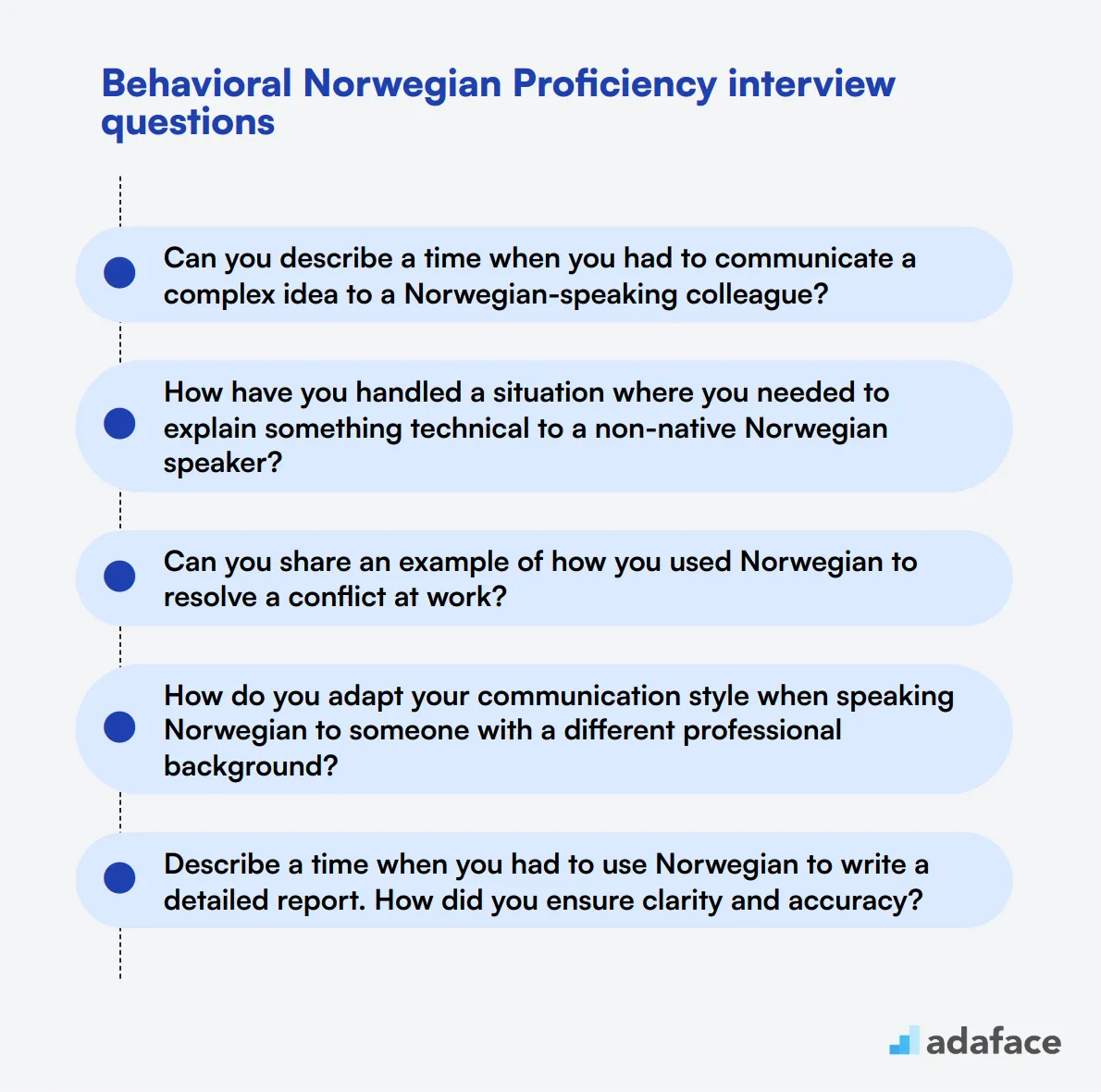
To assess an applicant's proficiency in Norwegian and their ability to handle real-life situations, it's important to ask behavioral questions. These questions help you understand how candidates have used their language skills in the workplace and how they might perform in your organization.
- Can you describe a time when you had to communicate a complex idea to a Norwegian-speaking colleague?
- How have you handled a situation where you needed to explain something technical to a non-native Norwegian speaker?
- Can you share an example of how you used Norwegian to resolve a conflict at work?
- How do you adapt your communication style when speaking Norwegian to someone with a different professional background?
- Describe a time when you had to use Norwegian to write a detailed report. How did you ensure clarity and accuracy?
- Can you discuss a project where you had to collaborate with Norwegian-speaking teammates? What challenges did you face?
- How do you manage to stay updated with industry-specific terminologies in Norwegian?
- Have you ever had to mentor or train someone in Norwegian? How did you approach it?
- How do you handle feedback on your Norwegian language skills from colleagues or supervisors?
- Can you provide an example of how you have used Norwegian in a customer service setting?
- Describe a time when your Norwegian language skills positively impacted a project outcome.
Which Norwegian Proficiency skills should you evaluate during the interview phase?
While it's impossible to assess every aspect of a candidate's Norwegian proficiency in a single interview, focusing on key skills can provide a comprehensive picture of their language abilities. Here are the core skills interviewers should evaluate during the interview phase.
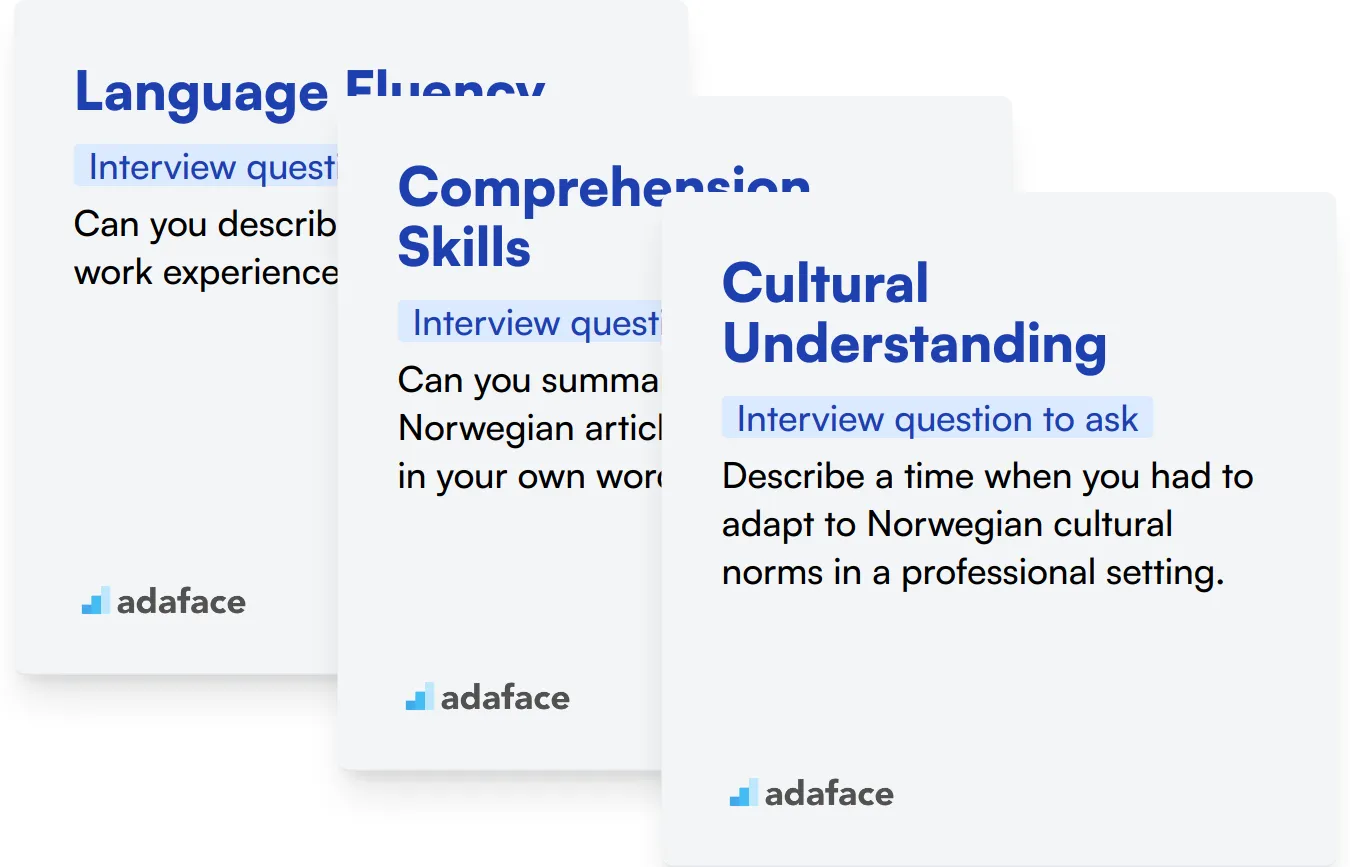
Language Fluency
To assess language fluency, consider using an assessment test that includes relevant MCQs. These tests can gauge the candidate's understanding of Norwegian grammar and vocabulary.
In addition to tests, you can ask questions that require the candidate to demonstrate their language fluency in real-time.
Can you describe your previous work experience in Norwegian?
Look for the candidate's ability to narrate their experience clearly and accurately. Take note of their pronunciation, grammar, and overall fluency.
Comprehension Skills
An assessment test with comprehension-based MCQs can help filter out candidates who struggle with understanding the nuances of the language.
Ask targeted interview questions that test the candidate's ability to comprehend and respond to Norwegian content.
Can you summarize this Norwegian article (provide article) in your own words?
Observe how well the candidate grasps the main points and details of the article. Pay attention to their ability to accurately relay the information.
Cultural Understanding
Though not always present in assessment tests, cultural understanding can sometimes be gauged through situational judgment tests or similar question formats.
You can assess cultural understanding by asking situational or behavioral questions that require the candidate to reflect on their experiences with Norwegian culture.
Describe a time when you had to adapt to Norwegian cultural norms in a professional setting.
Evaluate the candidate's awareness and adaptability to Norwegian cultural norms. This will indicate their potential for seamless integration into the work environment.
3 Tips for Effectively Using Norwegian Proficiency Interview Questions
Before you start implementing your newly acquired knowledge on Norwegian proficiency interview questions, here are some valuable tips to enhance your interviewing process.
1. Incorporate Skills Tests Prior to Interviews
Using skills tests before interviews can significantly enhance your candidate evaluation process. These tests provide objective data about a candidate's language abilities, helping you make informed decisions.
For assessing Norwegian proficiency, consider utilizing tests such as the Norwegian Proficiency Test that focus on reading, writing, and comprehension skills. This structured testing approach offers insights into the candidate’s proficiency level.
By integrating these tests into your hiring process, you not only streamline your candidate shortlist but also ensure that the candidates you interview are adequately prepared for the role.
2. Compile Relevant Interview Questions
It is essential to curate a focused set of interview questions to maximize your evaluation within the limited interview time. Choose questions that assess important aspects of proficiency while allowing candidates to demonstrate their skills effectively.
To complement your Norwegian proficiency questions, consider incorporating related queries about communication skills, cultural understanding, or problem-solving abilities. For example, you might want to review communication interview questions to enhance your evaluation framework.
By selecting relevant questions, you improve the probability of gauging candidates on key areas that are crucial for the role.
3. Utilize Follow-Up Questions
Simply relying on initial interview questions may not reveal the candidate's true competency. Follow-up questions are necessary to probe deeper into responses and uncover any inconsistencies or lack of depth.
For instance, if a candidate states they are fluent in Norwegian and can handle business communication, follow up with a question like, "Can you give an example of a challenging situation where you had to use Norwegian in a professional setting?" This prompts candidates to elaborate, helping you assess their practical application of the language.
Use Norwegian Proficiency interview questions and skills tests to hire talented translators
If you are looking to hire someone with Norwegian proficiency skills, you need to ensure they possess these skills accurately. The best way to achieve this is by using skill tests such as the French Proficiency Test or the German Proficient C1 Test.
Once you use these tests, you can shortlist the best applicants and call them for interviews. To get started, you can sign up here or explore our test library.
Pre-employment French Proficiency Test
Download Norwegian Proficiency interview questions template in multiple formats
Norwegian Proficiency Interview Questions FAQs
The list includes questions to initiate interviews, evaluate junior translators, assess language fluency, test cultural understanding, and situational and behavioral questions for hiring translators.
These questions help assess a candidate's language skills, cultural knowledge, translation abilities, and problem-solving skills in Norwegian-specific scenarios.
Yes, the questions range from basic to advanced, allowing interviewers to assess candidates at various proficiency levels, from juniors to experienced translators.
Interviewers should select questions relevant to the job role, combine them with skills tests, and use them to gauge candidates' language abilities and cultural understanding.

40 min skill tests.
No trick questions.
Accurate shortlisting.
We make it easy for you to find the best candidates in your pipeline with a 40 min skills test.
Try for freeRelated posts
Free resources




